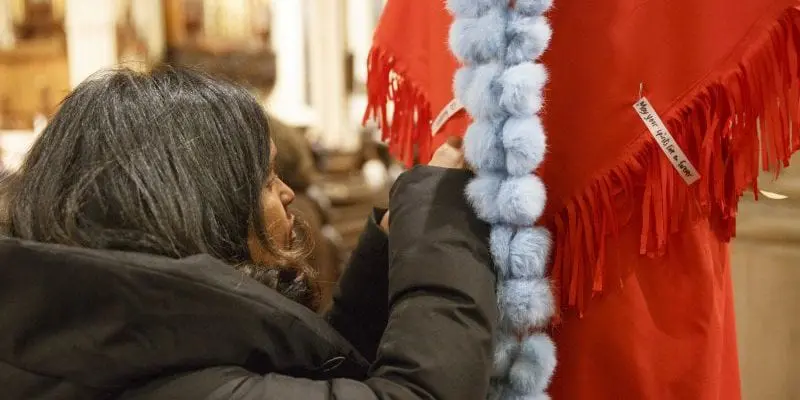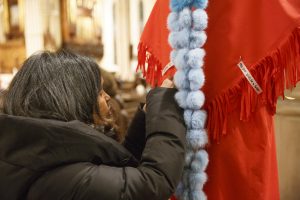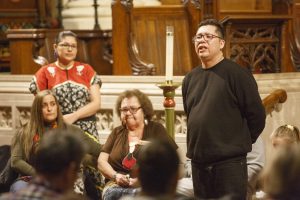
By Diana Swift
“Hi, Dad, I’m doing really great here,” reads an exuberant letter home from young Sonya Nadine Mae Cywink, a member of Whitefish Nation, Manitoulin Island and a prolific writer and aspiring poet even as a child. Known as “Whirlwind Woman” for her energy, Sonya, pregnant, was found dead near London, Ont. in 1994 at age 31.

Dozens of people braved Toronto’s icy February streets to offer support to the bereaved families of missing and murdered Indigenous women, girls and transgender and two-spirit persons (MMIWGT2S) at the opening of Shades of Our Sisters at St. James Cathedral on Feb. 15. Shades of Our Sisters is a recurring interactive multimedia exhibit that honours lives lost to the violence Indigenous women are especially prey to. It reveals the victims as vibrant young women with strong hopes and bright futures through stories, writings, photos, personal artifacts, film and the voices of their surviving relatives.
The project began to take shape in 2015-2016 with the bereaved families of Sonya Cywink and Patricia Carpenter. Patricia, 14 years old and a new mother, was found murdered at a downtown Toronto construction site in 1992. “She went to a birthday party and never came back,” said her mother, Joyce Carpenter of Alderville First Nation, near Cobourg.
Like other bereaved mothers, Ms. Carpenter is committed to perpetuating the memory and spirit of her daughter. The exhibit makes the point that far from being rejected runaways or street dwellers, these girls had families, were well loved and are still greatly missed.
The multimedia aspect of project, created in 2017 by Ryerson University production students, features two short documentary films exploring the two victims’ lives and personalities. Among the touching personal items on display are Patricia’s collection of Cabbage Patch Kids and her Brownie uniform. Most touching of all is a tiny hooded yellow baby suit. “That’s what I brought her home in from Women’s College Hospital,” said Ms. Carpenter.

The exhibit’s interactive features include a ceremonial red dress on which attendees can pin messages penned on gold or silver paper. Pinches of natural tobacco and lengths of red wool symbolizing connectedness and empathy are on offer. Most striking of all is a dazzling memorial mobile that dominates the cathedral nave, with coloured paper feathers bearing messages and prayers from visitors at other exhibit sites.
The formal part of the event on Feb. 15 opened with the honouring of the traditional Indigenous lands and burial grounds on which the cathedral stands, the ancestors who walked it for centuries before, and the nurturing presence of Lake Ontario. In a moving gesture, a moment of silence was held for Riya Rakjumar, the 11-year-old Toronto girl allegedly murdered by her father on her birthday the day before.
Speakers memorializing the deceased were preceded by traditional chanting and drumming led by Sue Croweagle, a Blackfoot from Piikani First Nation in Alberta, who identifies as a two-spirit person. Ms. Carpenter’s niece, Shauna Kechego-Nichols, offered to the gathering the powerful medicine of the healing jingle dance, wearing a ceremonial dress covered in rows of delicately tinkling metal cones.
Among the speakers was Patricia Carpenter’s brother James, who thanked the audience for sharing the beautiful cathedral space with the victims’ families and for showing their love and support. “It helps bring healing to the families and healing to the spirits. The spirits would be proud of us,” he said.

Mr. Carpenter acknowledged how hard it is for affected families across the land to speak of these losses. “It was 25 years before my mother would talk about what happened,” he said. “And far too often these stories bring hurt, but they also open our hearts to love.” He commended the families and their communities for their resilience.
Shades of Our Sisters is testimony to the families’ determination to keep their lost children alive in the minds of the living, even in those too young to have known them. Linda John of Six Nations, mother of Heleyna Rivera, recalled how it took years for her to come to terms with her daughter’s death in 2011 at age 25. She now tells young relatives who never knew Heleyna that she hasn’t really left them. “She lives in here,” Ms. John said, pointing to her heart.
Although the loss of these women is an unremitting source of sadness for surviving loved ones, this project is turning grief into celebration, healing and resilience. But as MMIWGT2S continue to be the subject of unresolved inquiries, the exhibit also reminds viewers of the racial disparities that exist in Canadian society and its justice system. Although only about 4.3 per cent of Canada’s female population identified as Indigenous in 2011, a disproportionate 11.3 per cent of missing women in 2013 were Indigenous, according to the RCMP.
The ceremony closed with interfaith prayers from members of Toronto’s Muslim and Jewish communities and from Bishop Mark MacDonald, national Indigenous bishop of the Anglican Church of Canada.
Shades of Our Sisters is open free of charge to the public from 7 a.m. to 5:30 p.m. on weekdays and Sundays, and from 9 a.m. to 5 p.m. on Saturdays, until March 1.
Diana Swift is a freelance writer.